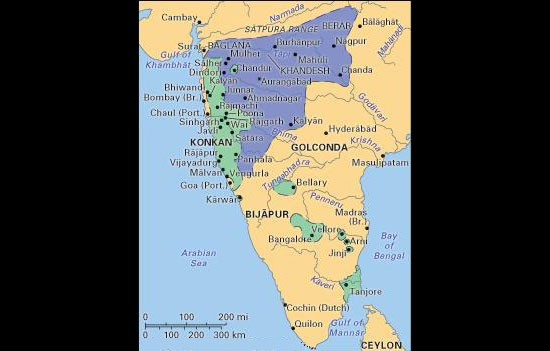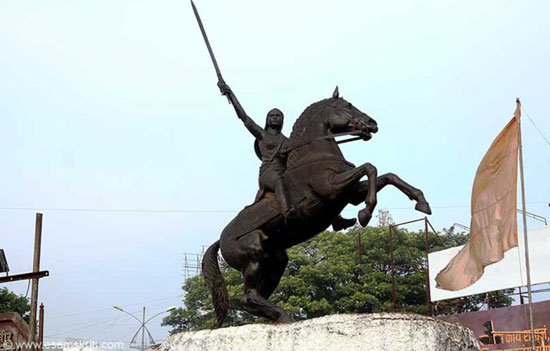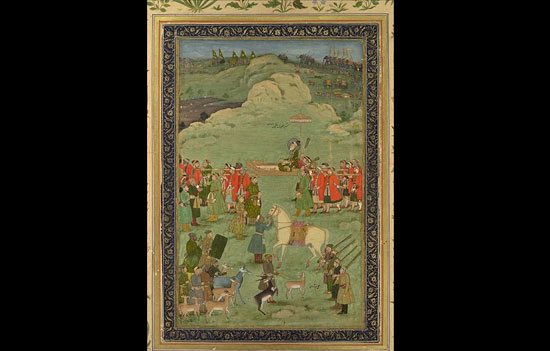- Did Aurangzeb conquer the Deccan or did his desire to defeat the Marathas, for which he shifted to the Deccan, contribute to his downfall. Excerpts from the book.
This is an excerpt
from the author’s soon to be released book ‘Aurangzeb-Whitewashing Tyrant, Distorting
Narrative.’
‘It may be also
asserted that if the monarch (Aurangzeb) maintains his design of becoming
master of all Shivaji’s fortresses, he will need, before he succeeds, to live
for as many years more as he has already lived.’ -Niccolao Manucci.1
Many of the Aurangzeb
hagiographers try to show him as the ‘Conqueror of Deccan.’ The contempt shown
by the Mughal chroniclers to Marathas is also copied almost verbatim when these
critics declare that ‘Marathas can’t stand and fight an open battle.’ A similar
stand is taken by the author in ‘the book,’ which has a severally flawed
narrative from the historical point of view. The Mughal-centric lens had
shielded them from seeing the expansion Maratha Empire had achieved in the
Deccan all the way to Tamil Nadu, even when the Mughal power was at its peak.
The charge of these critics that ‘Marathas were no match for the Mughals in an
open battle’ left us wondering how much Maratha history or military history
they have studied during their research.
Have they not
heard of the famous large-scale battles fought like the Battle of Vani-Dindori
after the second sacking of Surat in 1670? 2
Who has forgotten the famous Battle of Salher (1672), where the Maratha army
under Prataprao Gujar (C-in-C) and Moropant Pingale (Peshwa) decisively
defeated the Mughal army 1.5 times larger in size? 3 This was the bloodiest confrontation fought between Marathas and
Mughals. After this battle, the intensity, scale and frequency of clashes
increased. Battle of Titvala in 1683, Battle of Dodderi, Battle of Basavapattan
(both in 1696) are enough to show that Maratha forces were equal to the task of
taking on Mughal armies in open battle. 4
 Maratha Empire during Shivaji. Credits Nana Katya.
Maratha Empire during Shivaji. Credits Nana Katya.
The problem here
is not the battles or end results themselves but the mindset of certain
analysts and historians that ‘we can’t call this a legitimate battle unless
both the armies fight on the terms set by us.’ This is most baffling,
considering that why Maratha commanders will fight on terms and conditions of
the Mughal army or by their critics?
The armchair
Napoleons and Caesars who are criticizing the battle tactics must understand
that if Maratha army with minimum resources, less number of casualties (for
both sides), without erecting tower of skulls, are soundly defeating the enemy,
then what is the point in unnecessary comparison? Did these critics seriously
think that the expansion of the Maratha Empire from Attock to Cuttack and from
Tanjavur to Lahore happened by only hit and run raids?
Similarly, the
assertion that the Aurangzeb was a ‘Conqueror of the Deccan’ is based on a very
thin line of evidence. Was Aurangzeb really a ‘Conqueror of Deccan’ or had he
started on the path which ultimately led to the weakening and then the
destruction of the Mughal Empire?
 Queen Tarabai Kolhapur.
Queen Tarabai Kolhapur.
Phase Three of the 27 years war in Deccan
“Delhi city is looking very miserable today,
The
condition of the King of Delhi (Aurangzeb) is same,
Like
a fierce goddess Bhadrakali had killed the demons,
Maharani
Tarabai, Wife of Chhatrapati Rajaram, has killed Mughal soldiers.”
-- Kavi Govind
Paramanand (Grandson of Poet Paramanand) 5
By taking refuge
at Ginjee, Chhatrapati Rajaram had forced Aurangzeb to stretch his forces to
the breaking point on the vast fronts from Maharashtra all the way to Tamil
Nadu. After a prolonged siege, finally, Maratha nobles took the decision to
move the centre of gravity back to Maharashtra once again. The siege, which had
dragged on for eight years, had served its purpose. With Mughal reinforcement
moving towards Ginjee; it became increasingly difficult for Zulfiqar Khan also
to justify the delay in capturing it. Finally, he was able to capture the
Ginjee in January 1698, which was renamed Nasaratgad after his title of
‘Nasaratjang’. 6 The fort was
captured only after the Chhatrapati Rajaram and other important Maratha nobles
had already left for Vellore and then onwards to Maharashtra with a three
thousand strong Maratha cavalry escort. 7
The
last gamble
For the past four
years from May 1695 to October 1699, Aurangzeb has encamped at Brahmpuri
(renamed: Islampuri) on the banks of Bhima river, while his armies were
challenged and beaten all across the Southern part of India at various places
with much loss of life, valuable war materials and caused much financial drain
on the treasury. The inordinate time taken by Zulfiqar Khan to capture the fort
and his ultimate failure to capture the Chhatrapati; hints either towards
complacency or most probably duplicity. Mughal chroniclers as well as European
company officials both have noted, either cryptically or openly that the fort
has changed hand due to bribery, and Chhatrapati was able to escape due to the
connivance of Zulfiqar Khan. 8
This has left a
gaping hole in the overall planning of the Aurangzeb. As Chhatrapati himself
entered Maharashtra again, he realized that the war would become intense in the
near future. By this time, he had spent close to 19 years in Deccan but still
failed to subdue the Marathas. His most trusted nobles, including
Ghaziuddin‘Firoz Jung’ and Zulfiqar Khan ‘Nasaratjung,’ were not able to check
the growing Maratha power.
Hence he took a
decision with far-reaching consequences; that is, to start a campaign for the
capture of Maratha forts, with a hope that it would ultimately lead to the
downfall of the Maratha Empire. So on 19th October 1699, Aurangzeb
opened a campaign under his personal command against Maratha Empire. Saqi
Mustaid Khan quoted Aurangzeb’s words while opening the campaign against
Marathas as ‘My object in this journey is
nothing except holy war’. 9
The theme of holy
war here is not an isolated occurrence, but the same has been reported in
various akhbars & contemporary letters, which confirm that this was no
figment of imagination of later chroniclers. The first mention of ‘holy war’ in documents can be found in the
complaint letter dated 2nd November 1699, with the confiscation of
arms from representatives of Hindu nobles in Mughal camp. 10 This practice had been stopped only after a petition reached
Aurangzeb himself; as these Hindus were paying Jiziya and are fighting in ‘Holy
war’ for the Mughal government against Marathas. Consider some of the other
akhbar with the same theme given below;
 Tarabai Palace inside Panhala Fort, now a government office.
Tarabai Palace inside Panhala Fort, now a government office.
In the year 1700,
Sayyad Mazali, the brother of Gulbarga’s Qazi Abdullah has came to Emperor’s
camp (near Panhala) with fifty horsemen and fifty foot-soldiers. Through Yar
Ali Beg, he met the Emperor (Aurangzeb). Following gifts were given to him,
five hundred gold mohur, a sword, and two quivers. Sayyad Mazali requested that
he and his personnel had come to wage ‘holy war’ here. Aurangzeb exclaimed that
‘by God’s grace, I will kill the unbelievers with the stroke of my sword’.11
Similarly, Abul
Rasul from Akbarabad (Agra) wrote to Siyadat Khan that he is ready to come to
Deccan to fight in a holy war. ‘If the Emperor orders, I will come and fight in
Deccan’. 12 The fort commander of
Shivneri, Nasirullah Khan, has written to Aurangzeb, ‘as you have declared the
holy war against non-believers, I want to participate in this war. If you
permit, I will keep my deputy Sheikh Hussain here and will join you with 500 of
my best troops.’ Aurangzeb was very pleased and ordered him to ‘come at once. 13
Since ‘the author’
has completely ignored the words and the subsequent acts of Aurangzeb, which
mention his focus on ‘holy war,’ the critical analysis of this phase is totally
absent from the narrative. So like Aurangzeb roamed Maharashtra aimlessly,
laying sieges and taking the forts in the vain hope of subduing the Marathas,
even ‘the author’ is roaming aimlessly in the wilderness of the questions for
justifying the actions of Aurangzeb from 1699 till his death in 1707.
The peace terms
offered by Maharani Tarabai after the death of Chhatrapati Rajaram were
rejected brusquely in July 1700 by the Aurangzeb. In fact, the death of
Chhatrapati gave further hope to him that if given a strong push, the collapse
of the Maratha Empire is imminent. Hence he ordered fresh reinforcements.
Table
19.1: Reinforcements called by Aurangzeb to Deccan in 1700 for final push against Marathas. 14
|
No
|
Province
|
Governor
|
Nature
of reinforcements
|
|
1
|
Kabul
|
Prince Muazzam
|
2000 musketeers,
2500 horses & 500 camels
|
|
2
|
Ahmadabad
|
Shujaet Khan
|
1000 horsemen
|
|
3
|
Ajmer
|
Sayyad Khan
|
1000 horsemen
|
|
4
|
Malwa
|
Mukhtar Khan
|
1000 horsemen
|
|
5
|
Gwalior
|
Jan Nisar Khan
|
1000 horsemen
|
|
6
|
Agra
|
Itikad Khan
|
1000 horsemen
|
|
7
|
Itawa
|
Khairandesh Khan
|
1000 horsemen
|
|
8
|
Awadh
|
Zabardast Khan
|
500 horsemen
|
|
9
|
Burhanpur
|
Muhammad Kambu
|
500 infantry
|
|
10
|
Allahabad
|
Siphadar Khan
|
1000 musketeers
|
Every Governor was
supposed to pay the salary in advance as well as to give up to Rs. 20,000 to
the units coming to Deccan for their upkeep along with their weapons and
horses. But till October 1700, no reinforcements came from Ahmadabad; hence
Aurangzeb reduced the ranks of all major officers posted there.15 In-fact, Shujaet Khan from Ahmadabad
has informed that the number of soldiers ready to serve in the Deccan war is
very less; hence he is planning to send three lakhs for the imperial treasury
in place of the soldiers. Aurangzeb sent a harsh reprimand to Shujaet Khan; ‘I am waging the holy war for the
destruction of evil unbelievers, and for that, I am constantly taking strenuous
efforts. You need to help an Islamic King in this with your soldiers’.16 The reprimand had the desired effect
on Khan and by the end of December 1700, he sent his son Najar Ali to fight
against Marathas.17 Now a military
commander whose army’s pay has been in arrears from six months to more than a
year must have jumped on such an offer, but Aurangzeb’s rebuke to Shujaet Khan
shows how serious he was regarding the war till the bitter end.
 Aurangzeb hunting. Courtesy Khalili Collection of Islamic Art.
Aurangzeb hunting. Courtesy Khalili Collection of Islamic Art.
Whereas Muhammad
Murad Khan (the patron of Khafi Khan) has written from Godhra that ‘when you, my lord are waging holy war
against unbelievers and here I am enjoying my life is not acceptable to my
conscience. Hence, sire, if you order me, I will keep my deputy at Godhra and
come to your camp to wage the holy war along with you. Even if I get a
miniscule part of your righteous war, I will be much happy in life and after’.18
He reached at the time siege of Panhalgad in early 1701.19
The musketeers
sent by the governor of Allahabad also reached in January 1701 to Aurangzeb’s
camp. Muhammad Saleh, the son of Itikad Khan (Governor of Agra), reached
Aurangzeb’s camp with his unit in February 1701.20
 Aurangzeb on a
palanquin. Courtesy Bhavanidas.
Aurangzeb on a
palanquin. Courtesy Bhavanidas.
As Aurangzeb took
the personal command for the sieges of the Maratha forts, he forgot the key
principle of delegation and not to micro-manage everything. Earlier, the will
of the Emperor was supreme for even routine things, but with this decision, the
micromanaging reached its peak. The camp of Aurangzeb was not only military but
also contained all his administrative departments. But when he focused
everything on sieges and battles instead of planning strategy, then running
administration of the Mughal Empire naturally took a backseat.
The stage has now been
set for the final showdown between Mughal and Maratha Empires.
To read more buy
book, click HERE
About Author: Saurabh is an avid reader and keen researcher,
especially in the history of Maratha Empire. This is an excerpt from his soon to be
launched book which is being published by Evincepub Publishing.
About the Book: It is a combination of meticulous research with a lucid plot. The current narrative which is getting built around him like, ‘much misunderstood king’ and ‘protector of temples’ has prompted the author to look for historical accuracy of this new portrayal. Who he really was? As described by his court records and contemporary chronicles or as reinterpreted by modern historians?
This book is an
attempt in fact finding where the author tries to critically examine the life
of Aurangzeb with contemporary records. Today when the debate is raging
passionately across academic circles and on social media platforms, this work
has become all the more relevant and essential.
Also read
1. Battle
of Salher
2. Maratha
rule in Thanjavur
3. Return
of Queen Yesubai
4. How
the Marathas captured Attock in modern day Pakistan
5. Album
Panhala Fort
References
1. N.Manucci, Storia do Mogor -Volume-III, Tr-W.
Irvine, Pg-306, 1907.
2. K.A.Sabhasad, Sabhasad Bakhar, Tr-S. Sen Pg-87-88.
1920.
3. Ibid,
Pg-103-04.
4. J.Sarkar, History of Aurangzib-Volume- IV. Titvala:
Pg-303-04, 1930. &
S.M. Khan, Maasir-i-Alamgiri, Tr-J. Sarkar, Dodderi: F-376-78, Pg-228-
29, Basavpattan:
F-379, Pg-230. 1947.
5. G.S.Sardesai,
Aitihasik Patrabodh, Pg-24, 1952.
6.
C.S.Srinivasachari, History of Gingee and
its Rulers, Pg-338. 1943.
7. Ibid, Pg-336.
8. Ibid, Pg-338
& 347.
9. S.M.Khan, Maasir-i-Alamgiri, Tr-J. Sarkar. F-410,
Pg-249, 1947.
10. S.M.Pagadi, Mogal Darbarachi Batamipatre-Volume-1, O
Pg- 260. 1978.
11. Ibid, O
Pg-305.
12. Ibid, O
Pg-317.
13. Ibid, O Pg-
359.
14. Ibid, O Pg-
396, 397, 399, & S.M.Pagadi, Mogal
Darbarachi Batamipatre-
Volume-2, O Pg-53, 1983.
15. S.M.Pagadi, Mogal Darbarachi Batamipatre-Volume-1, O
Pg-427, 1978.
16. S.M.Pagadi, Mogal Darbarachi Batamipatre-Volume-2, Preface-
O Pg-36.
1983.
17. Ibid, O Pg-53
& 99.
18. Ibid, Preface
O-Pg-36.
19. Ibid, O Pg-90.
20. Ibid, O Pg-68.